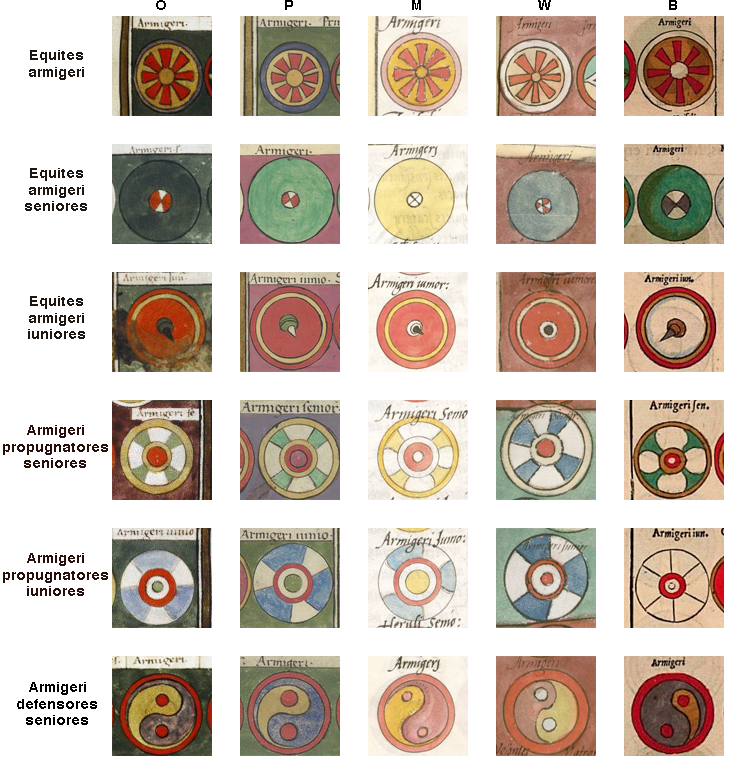
This page created 1 January 2004, and last modified: 31 July 2015 (Maier reference links added)

Thirteen units of armigeri are apparently noted in the Notitia, eight of them horse (the numbers in front of the names refer to Ingo Maier's numbering scheme):
(9.10) Equites armigeri seniores Gallicani, a comitatenses vexillation under the Magister Militum Praesentalis Iand three of them legionary infantry units:
(15.4) Equites armigeri seniores orientales, a comitatenses vexillation under the Magister Militum per Orientem
(74.7) Cuneus equitum armigerorum, under the Dux Scythiae
(76.5) Cuneus equitum armigerorum, under the Dux Moesiae secundae
(76.6) Cuneus equitum secundorum armigerorum, also under the Dux Moesiae secundae
(102/5.13) Equites armigeri, a comitatenses vexillation listed in the Magister Equitum's cavalry roster
(102/5.25) Equites armigeri seniores, a comitatenses vexillation under the Comes Africae (102/5.235)
(102/5.39) (Equites) armigeri iuniores, another comitatenses vexillation under the Comes Africae
(98/9.027) Armigeri propugnatores seniores, a palatine legion under the Comes Africaeand the following two units which are probably duplicates of two of the above:
(98/9.32) Armigeri propugnatores iuniores, another palatine legion under the Comes Africae
(98/9.101) Armigeri defensores seniores, a comitatenses legion in the Magister Equitum's Gallic command
(102/5.224) Equites armigeri seniores, under the Magister Equitum's Gallic command, and to be equated with 102/5.13Armigeri should probably imply 'armoured', and given most soldiers were armoured to some extent, likely 'heavily armoured'. Accordingly, some have taken the cavalry armigeri units to be the equivalent of horse catafracts. However, this is just one of many possible explanations of the title, and leaves open the question of what the foot units are. (Armigeri also has a broader meaning of "equipped, especially for war", but of course any soldier has an even higher probability of being merely equipped for war than of being armoured).
(156/8.8) Armigeri, a unit of milites under the Dux Mogontiacensis, and likely to be equated with 102/5.101.
Only the shield patterns for some of these units are shown in the Notitia:

Those under O come from the Bodleian manuscript in Oxford, those under P from the Paris manuscript, those under M from the first portion of the Munich manuscript, those under W from the second portion of the Munich manuscript, and those under B from the Froben edition.
Given that the three foot units all appear to have equivalent mounted units serving under the same commander, it might appear that these particular mounted armigeri units (if not the others) might derive from the mounted portions of older legions; and it may be that the other mounted armigeri are likewise derived from legionary horse (in the same way that the various Equites promoti seem to have been), and that the question of what "armigeri" are then boils down to 'why are some legions called "armigeri"?'
It is of course entirely possible that the men of these legions were particularly well armoured (at least, at the time they were formed); another explanation could be that they earned the description as a nickname or badge of merit, in the same manner as Cromwell's "Ironsides" did in the British civil wars of the 1640s - these men were not particularly well-armoured (not even in iron, but buff-jackets for most part), but their behaviour was certainly steadfast. Perhaps one (or more than one) legion's resoluteness in action earned it a cognomen, which as time went on became the 'officially recognized' primary name of the unit, bequeathing its name to various detachments as recorded in the Notitia.
Such nicknames and/or merit names being transferred into 'official' names (i.e. official enough to be listed in the Notitia Dignitatum, the 'register of officials') would certainly be far from unique. Propogunatores for example is almost certainly such a name ('the Defenders'); and there are many units entitled Victrix ('Victorious') in the Notitia, deriving from battle honours from long-past actions.
Two units bear the related designation of "armaturarum":
(23.7) Schola armaturarum iuniorum, under the eastern Magister Officiorum"Armaturarum" has a very similar meaning to armigeri, but being somewhat broader: "equipped, especially armed with weapons". As with armigeri, it is unclear how this label distinguishes them, if at all, from their fellows. See my discussion on Scholae for more details.
(107.4) Schola armaturarum seniorum, under the western Magister Officiorum

Return to the Notitia index page.